Elegant in its simplicity, the Rhodes 18 has many attributes that have made it a classic among the daysailing and weekend one-design racing classes. Similar in many ways to the Sparkman & Stephens Lightning Class boats I grew up sailing and racing on Long Island Sound, it is dynamic, lively, quick to accelerate, maneuverable, and sails magnificently.
A soft chine and graceful longitudinal rocker contribute to the boat’s maneuverability and great turning characteristics. The outboard rudder, hung with a standard pintle-and-gudgeon arrangement on a transom that is flat and has slight reverse rake, allows the boat to carve tacks and jibes efficiently. A 5″ skeg extends from the bottom of the transom and tapers forward 3′ to ensure good tracking qualities. The graceful bow curve has a soup-spoon shape, which complements the hull form. By my observations, the transom is the only flat surface of the entire hull of the Rhodes 18. From stem to stern and along each station, the boat is as fair as a beach stone.
The Rhodes is the perfect daysailer for up to five people, or it can be raced by a crew of three in one-design fleets. The cockpit is spacious, comfortable, and practically designed, with port and starboard longitudinal benches for comfortable seating for three on both sides of the cockpit. The cockpit coaming lies flush with the deck, which is a significant attribute when you and the crew are hiking out with legs extended over the edge of the cockpit and side decks. The cockpit is set back by about 10″ to the inboard from each side, allowing for significant deck edge immersion, which helps to stave off swamping. The foredeck, which extends from the stem to just aft of the mast, provides a stable platform to pick up the mooring line, set an anchor, or tie off a dockline. From the afterdeck, which is equally ample, such necessary tasks as fastening the boom tent or tying off the tender can be completed.
For a centerboarder, she is a forgiving and relatively stiff 18-footer, which you especially notice when stepping aboard before the centerboard has been lowered. Her initial stability feels reassuring when you move your weight around the boat. Under full sail and in a moderate breeze, the Rhodes 18 is well balanced and easy to rein in.
I came to know the Rhodes 18 because for a number of years I’ve enjoyed sailing PYG, a wooden-hulled boat that my friend Richard Van Voris restored in Massachusetts. With a little review of Greek mythology, I found that PYG is aptly named: According to the myth, the sculptor Pygmalion created a statue so life-like that he fell in love with it. After becoming familiar with the Rhodes 18, I can easily understand how any owner would become so enamored. Michael Warr, PYG’s previous owner, described the Rhodes 18 as “a perfect little lady with no bad habits.” Ultimately, when asked to write about basic sailing techniques in WoodenBoat magazine’s “Getting Started in Boats” section (see WB No. 218), I chose the Rhodes 18 as the model for its all-around characteristics. I tried sailing her alone, without crew, just under the mainsail alone, and PYG remained a gracious silent partner without any noticeable weather helm.
The key to sailing any centerboard boat like the Rhodes 18 is to sail her flat. Those of us who teach sailing preach, “Flat is fast.” On the Rhodes 18, this translates into either hiking harder, adding additional crew for extra ballast, sailing under main alone, or even taking a reef in the mainsail. On the wind or on a reach, the adjustable centerboard position on the Rhodes 18 can be “played” up or down a small amount to change the center of resistance and thereby change the balance of the boat. This adjustment corrects the boat’s tendency to head up into the wind or to fall off away from the wind. Downwind, the centerboard can be raised entirely to reduce drag and increase speed.
The boat is easy to manage on a trailer or to leave on a mooring with a boom tent over her cockpit to keep the water out of her bilges. There is also plenty of storage under the foredeck or under the afterdeck to store necessities.
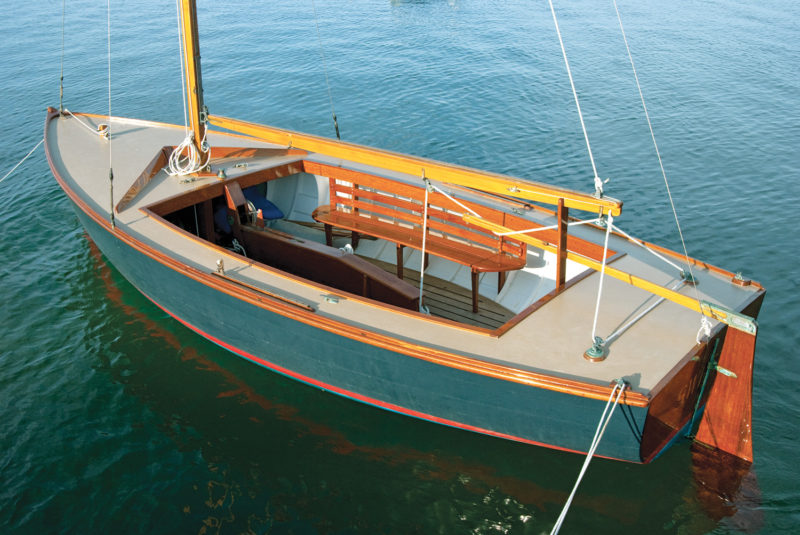 Donald Sorterup
Donald SorterupSWIFT gives an excellent idea of what the Rhodes 18s looked like when the type was new. Peter Eastman, who has won numerous Rhodes 18 national championships, found the boat in a barn and restored her to original specifications.
The Rhodes 18 is the work of yacht designer Philip L. Rhodes (1895–1974), who designed everything from 7′ dinghies to 123′ motoryachts. Arguably his most famous design was the 12-Meter WEATHERLY, the 1962 AMERICA’s Cup winner. According to Richard Henders on’s excellent biography Philip L. Rhodes and His Yacht Designs, the designer drew his 18′ daysailer in 1938 for use as a junior trainer for the Stamford (Connecticut) Yacht Club.
At present, Rhodes 18 racing fleets remain active at Barnstable Yacht Club and Dennis Yacht Club on Cape Cod and at the Biddeford Pool Yacht Club in Maine. The International Rhodes 18 Racing Association (see www.biddefordpool.org/bpyc/public/rhodes_18/rhodes_18.htm), sponsored by the Biddeford Pool Yacht Club, specifies strict rules and regulations for boats and sails that must be followed by racing contestants.
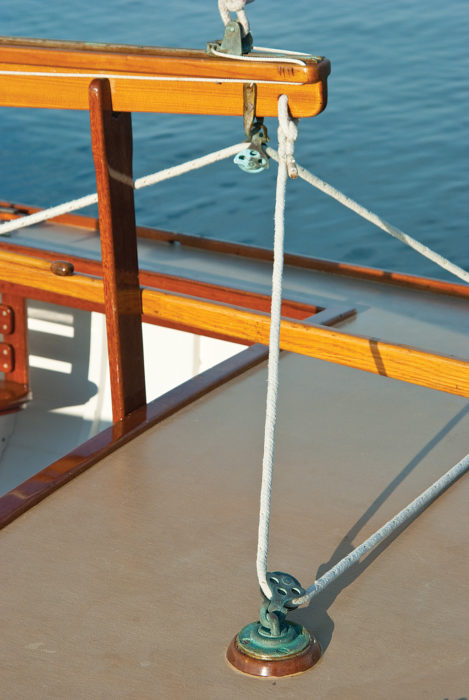 Donald Sorterup
Donald SorterupIn the original rigging plan, which is retained in SWIFT, the boom has a “T” cross-section, and the mainsheet reeves through deck-mounted turning blocks without a traveler.
The Rhodes 18 fleet quickly adapted to fiberglass construction in the post–World War II era. The Cape Cod Shipbuilding Co. in Wareham, Massachusetts, which advertised a complete wooden Rhodes 18 with mainsail and jib for $718 in 1942, started building fiberglass versions as early as 1948. Since then, the company has launched some 700 of them in both centerboard and keel versions.
The fiberglass keelboat and centerboard Rhodes 18s are raced together. Additional weight is added to the centerboard boats to bring them up to the set minimum weight requirements and to make them equal in weight to the normally heavier keelboats. The fractional-rigged Rhodes 18 is raced with any combination of mainsail, jib, genoa, and spinnaker. According to Peter Eastman, six-time winner of the Rhodes 18 Nationals, about 25 boats turn up for the competition. Eastman is fond of sailing the Rhodes 18 because “it is a family kind of [sailboat] class.”
It is unknown how many wooden Rhodes 18s were built, but they are rare today. Despite all that I have said about the graceful and handsome wooden Rhodes 18, the truth is that the wooden version of this daysailer is a dying breed. According to Eastman, only a handful of them still exist, and only two wooden boats that he knows of are still sailing. Many boatbuilders dream of coming across a rare boat tucked away in an old barn somewhere, but unless you are willing to obtain plans from Mystic Seaport and undertake an extensive building project in wood, a new or used fiberglass Rhodes 18 may be the only realistic way to enjoy this classic daysailer.
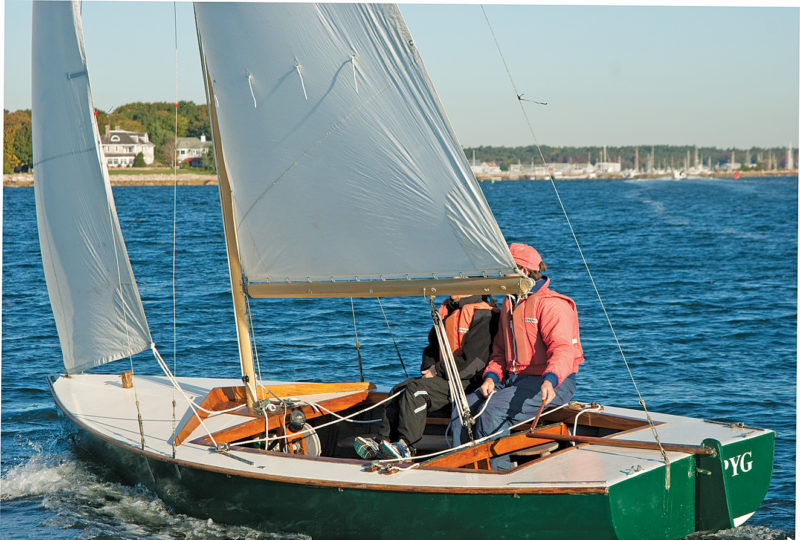 Donald Sorterup
Donald SorterupRichard Van Voris of Massachusetts completed a fine restoration of PYG, one of a handful of surviving wooden-hulled Rhodes 18s. Philip Rhodes was an early advocate of fiberglass construction, and in 1948 production manufacturing of his 18-footer began in that material.
Building anew, of course, is not out of the question for an experienced builder, and constructing a Rhodes 18 could be the experience of a lifetime. To learn more about the construction of the boat, I ventured to the Daniel S. Gregory Ships Plans Library at Mystic Seaport, Connecticut. The collection includes more than 300 designs by Philip Rhodes, including the Rhodes 18, which is his design No. 448 and Mystic Seaport’s Catalog No. 80.132. In 21 separate sheets, Rhodes supplied every necessary detail, although the original construction plan (sheet No. 14) is in very poor condition.
Rhodes’s original specifications called for a 5⁄8″ galvanized steel centerboard or an iron ballast keel. The timber keel was to be either white oak or longleaf pine, with continuous white oak frames 7⁄8″×7⁄8″ on 8″ centers, and with 5⁄8″-thick cedar carvel planking fastened with bronze or Monel screws. He called for varnished mahogany trim, canvas-covered plywood decks, Sitka-spruce spars, stainless-steel rigging, and bronze fittings.
Should time constraints or a lack of experience preclude the “build it yourself” approach, another option might be to save and restore an existing Rhodes 18—if one can be found. This is a quicker way to get out on the water on a wooden Rhodes 18 while retaining some of the hands-on experience of boatbuilding and all of the satisfaction of restoring a classic, as my friend Richard found with PYG. He sistered or replaced frames, replaced her mast and sails, rebuilt her center-board trunk, and duplicated or renewed many of PYG’s wooden structural and trim pieces. Essentially, PYG is as good as new!![]()
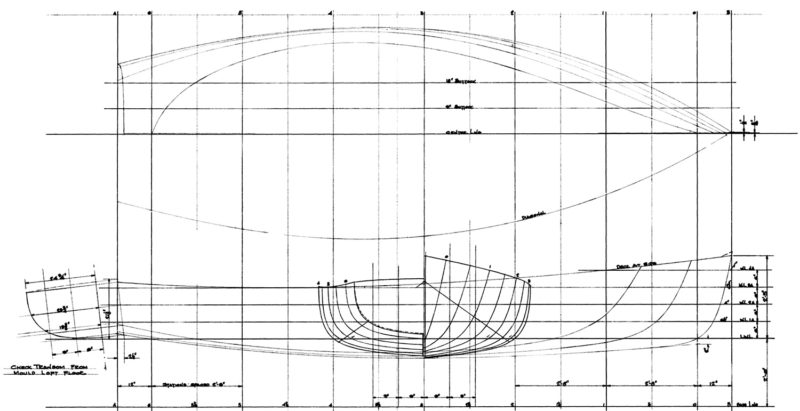
Philip Rhodes drew the 1938 plans for the Rhodes 18 for construction by the Cape Cod Shipbuilding Co., which built them initially in wood, starting fiberglass construction, including a later fin-keel variation, in 1948. Like all of Rhodes’s plans, those for the Rhodes 18 reside at the Daniel S. Gregory Ships Plans Library at Mystic Seaport in Connecticut.
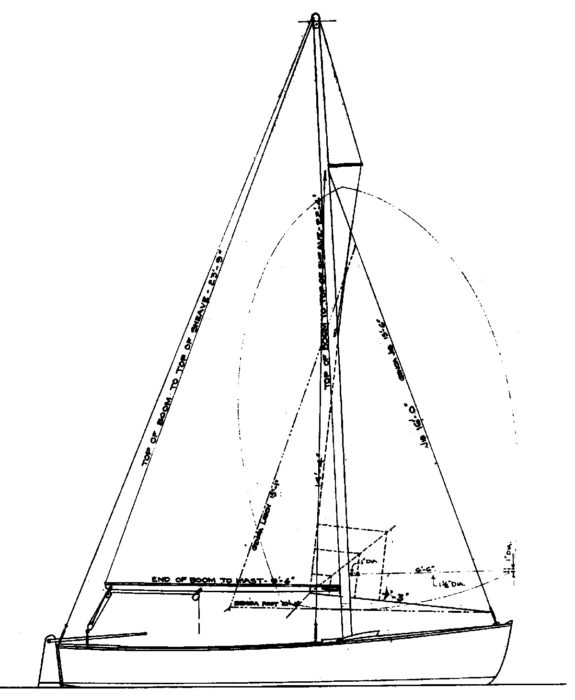
Particulars: LOA 18′, LWL 16′, Beam 6’3”, Sail area 162 sq ft
—
Plans for the Rhodes 18 are available from Mystic Seaport.


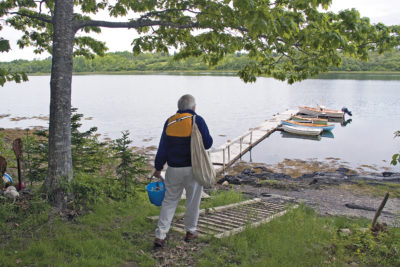
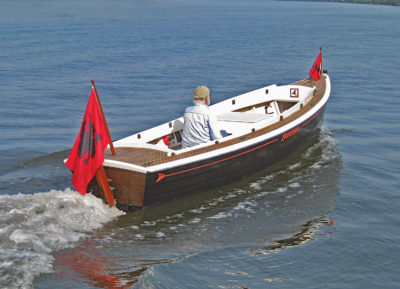
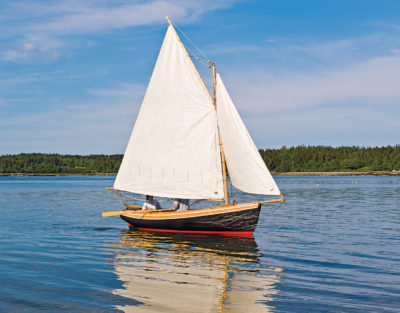
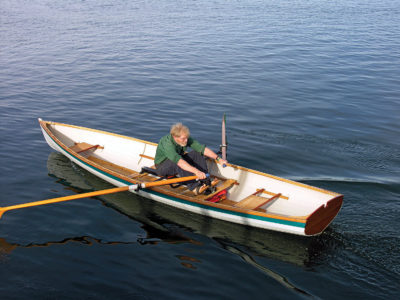
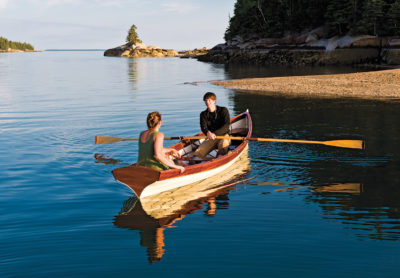

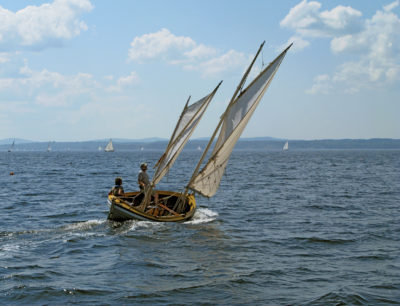
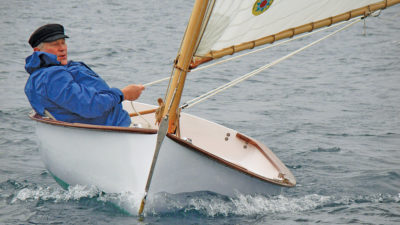
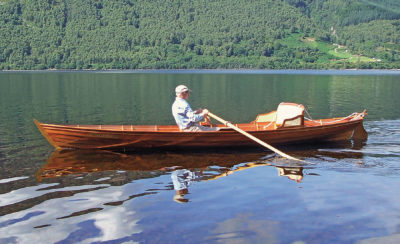
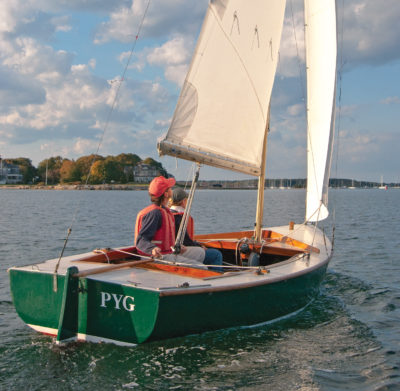
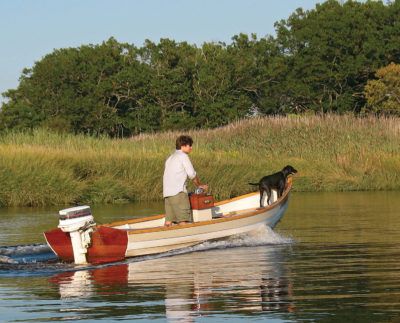
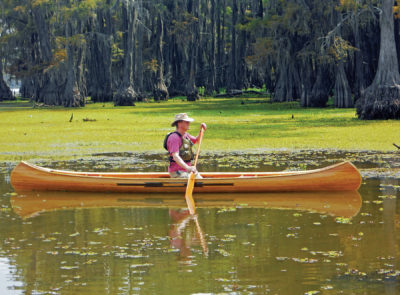
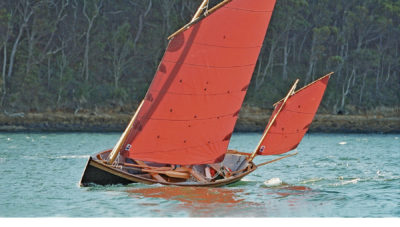
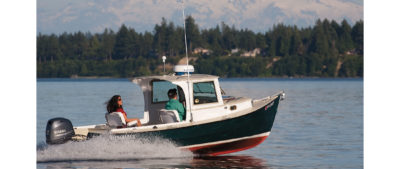
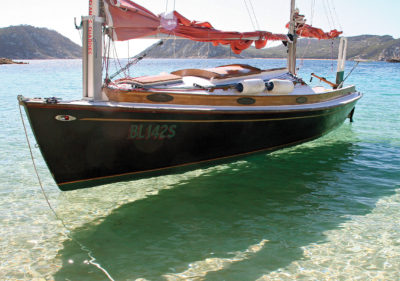

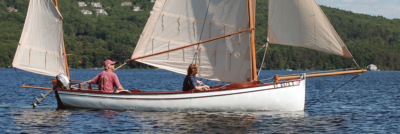
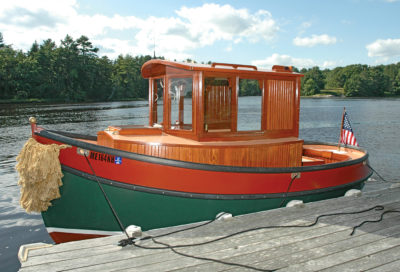
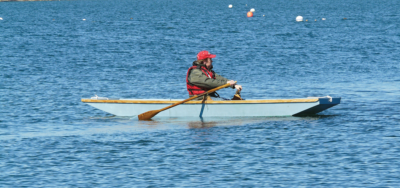
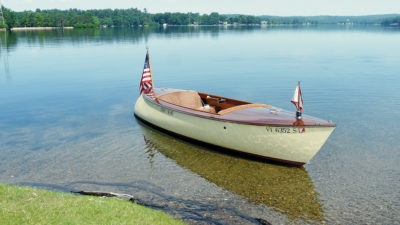
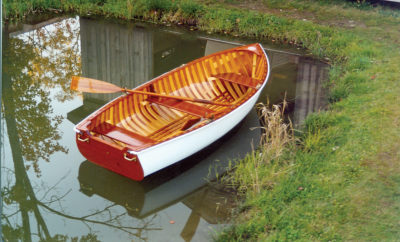
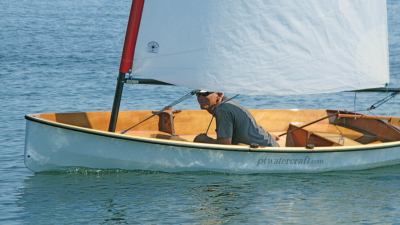
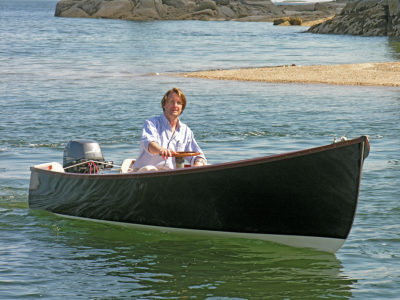
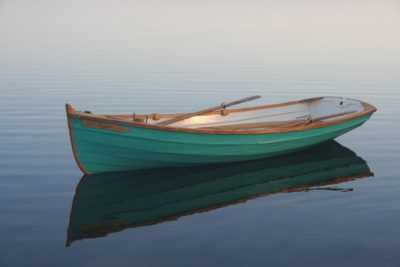
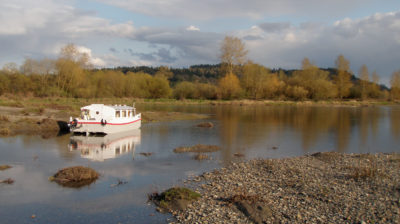


My experience with the fiberglass Rhodes 18 centerboard boat is its manufacturer didn’t redesign the floatation from the keel version. When capsized it is stable upside down, and when one tries to right it with pressure on the centerboard, the bow dives down because there is no flotation in the bow.
Herman,
This flotation issue is well recognized. To offset the factory/design issue, for many years, the Class has required additional flotation in the bow of all boats. Here is an excerpt from the Rhodes 18 Class Rules & Specifications:
(1) c) Flotation – The airtight integrity of the seat tanks in the fiberglass boats must be maintained. In all boats, two cubic feet of positive flotation must be placed as far forward under the bow as possible.
I have a wooden 1948 Rhodes 18 from Cape Cod Shipbuilding. I’ve owned and sailed COBWEB for 20 years and am happy to have found this article on these wonderful sailboats.